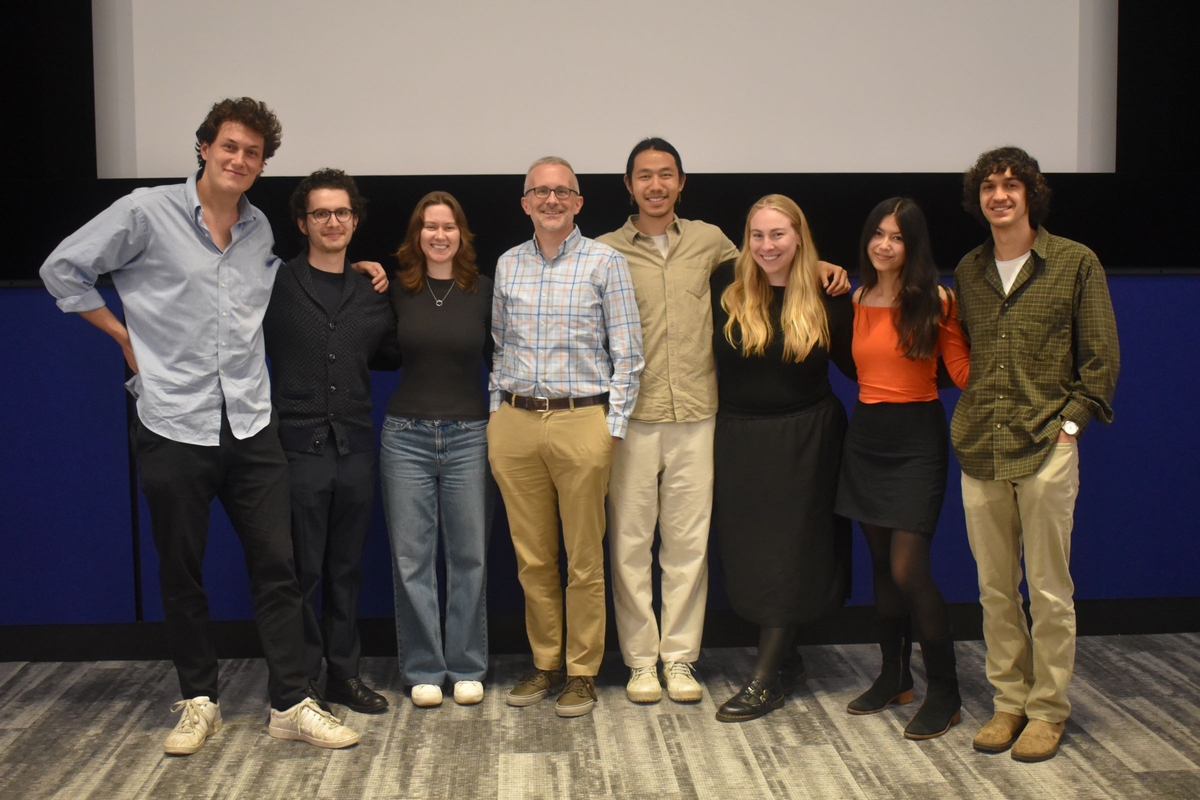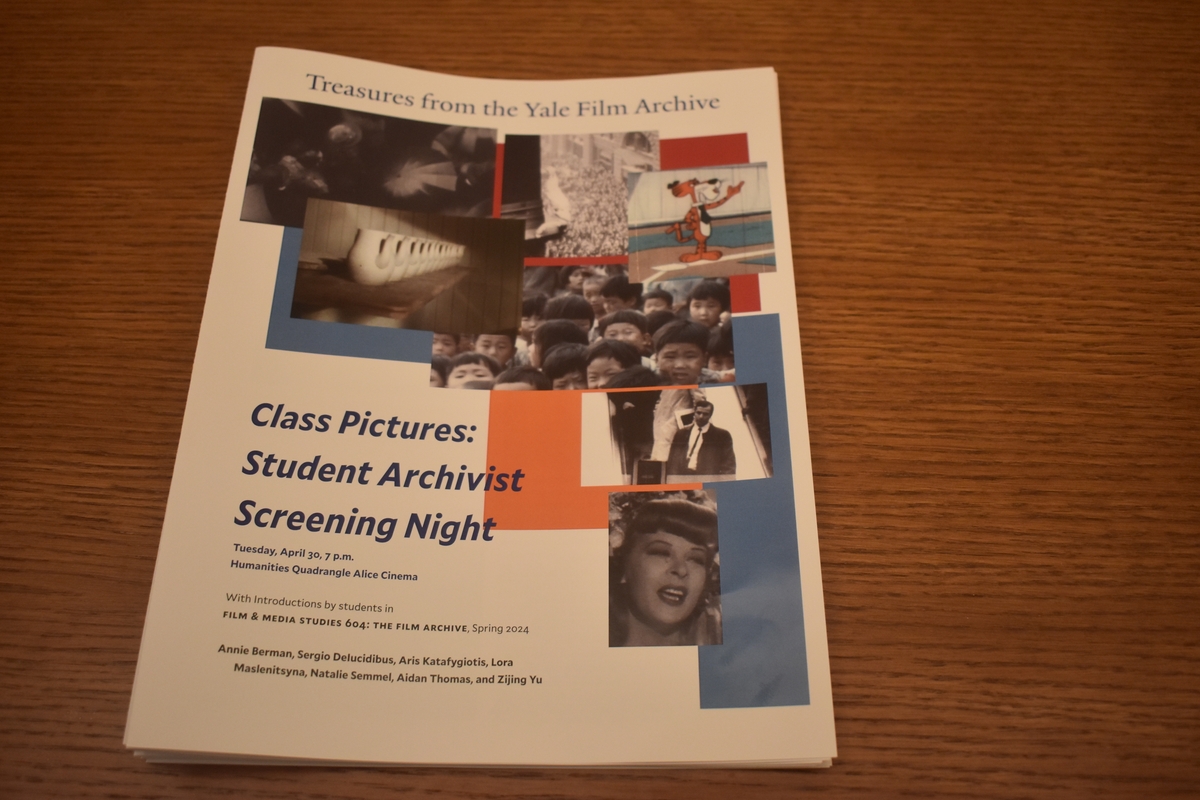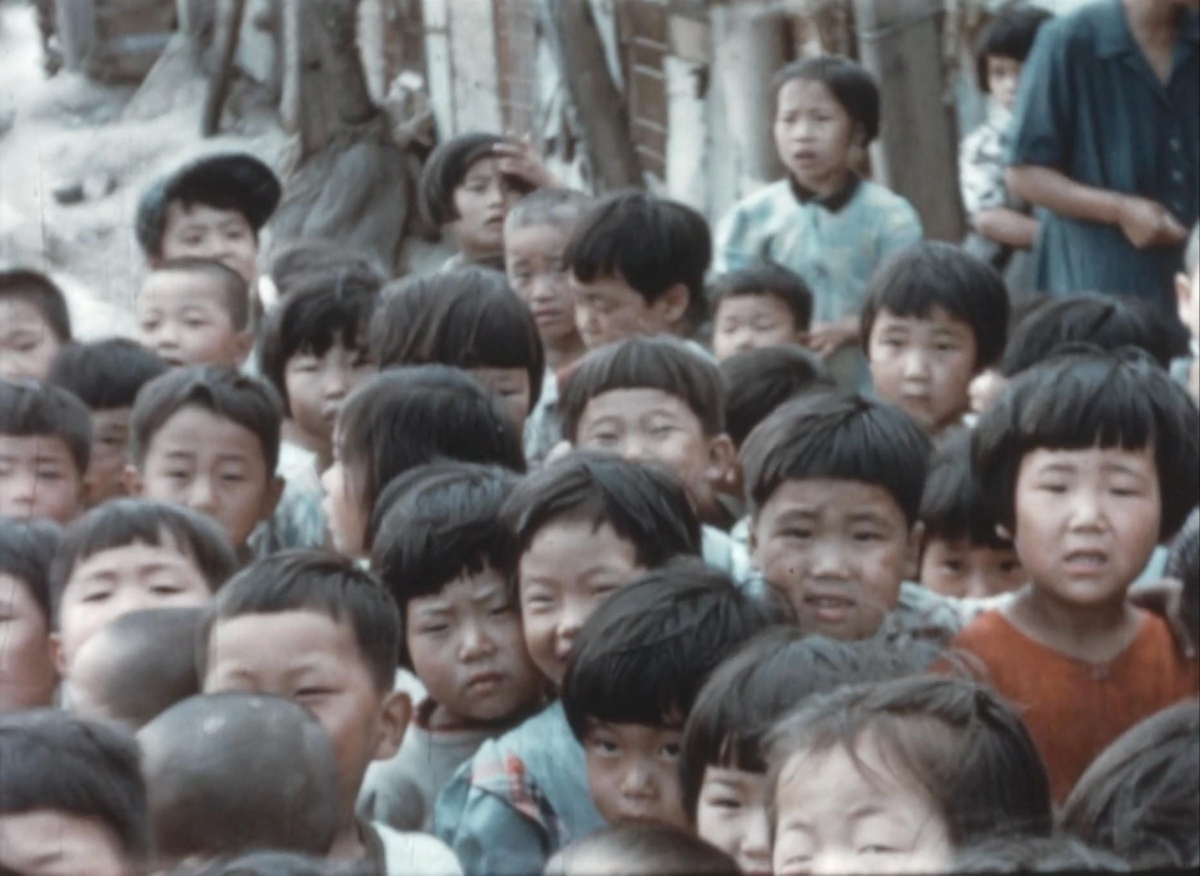
Karen Ponzio Photo
Brian Meacham and student archivists.
Yale Film Archive turned one of its screening events over to students Tuesday night as members of the Spring 2024 Film and Media Studies 604 class shared their archivist projects — which included everything from a not-so-silent Dutch short that focused on the rain to a Looney Tunes cartoon that focused on a not-so-cool cat — with a room full of appreciative movie fans.
“This is a really special evening,” said managing archivist Brian Meacham, who is also the instructor of that film archive class, which he has taught every other year since 2016. He began the evening with a brief explanation of what the event, which he called one of his favorites, was all about. Each student was asked to find a 16-mm print of a film, “something researchable,” that they would then work on archiving for YFA and would screen at this end of semester event.
“We basically give students 50 bucks and say ‘go on eBay,’” he said with a laugh.
This year the class had seven films — which Meacham noted was “a record for this show” — that spanned 50 years of cinematic history.
“I think you’ll be really amazed,” he added.
Each student wrote about their film for the program handed out to attendees and spoke about their film before screening it.

Karen Ponzio Photo
The program for the evening.
Annie Berman introduced “Colour in Clay,” a 1941 Technicolor educational short from England that focused on Wedgwood pottery making. Its cinematographer was Jack Cardiff, well known for his work on such classic feature films as The Red Shoes and The African Queen. If you are familiar with those films, it is easy to see his hand in this one. He captures the lush colors of the paints used and the clothes worn by the painters themselves as well as the mesmerizing artistry of the potters. “Colour in Clay,” had other small but impactive touches, such as the often-dramatic narration that included the line “ready for the ordeal by fire” when the pottery was to be placed in a kiln.
“Regen,” a 14-minute film that focused on a rain-soaked city in the Netherlands, was introduced by Sergio De Iudicibus as an “atypical city symphony” that took its director, Joris Ivens, two years to film. He noted that Ivens even had “rain watchers” to help him capture the weather, which becomes its own character as well as a form of narration.
“Silent film was never quite silent,” said De Iudicibus after inviting the audience to pay more attention to the “sounds of the film,” as opposed to its musical score. The building of swelled grey sky to scattered raindrops to downpour becomes a poetic symphony unto itself as the city and its inhabitants move forward through their day. Ivens gives loving attention to single drops as well as a symphony of rivulets and swirling umbrellas.
“Old Russian Jubilee” offers two songs and a flaming sword dance, though presenter Lora Maslenitsyna noted that this film was more of a “lighthearted affirming piece of Russian fiction” than a detailed factual account of Russian culture. The seven-minute film from 1943 features Gertrude Niesen, who was a popular singer and actress of the time. According to Maslenitsyna, it was most likely three songs long with one spliced out (it ends abruptly). Both Niesen’s performance and the film itself offer a definitive slice of that time.
Zijing Yu presented “Cry of the China Seas” — at 25 minutes the longest of the films screened — with background information uncovered about one of its producers, Cathedral Films, which made religion-based films. This 1958 “ideologically charged” selection was one of many that would be distributed to churches, this one focusing on the missionary work carried over from America to South Korea, Taiwan, Hong Kong, and the Philippines after the Korean War.
He invited us to watch this piece of filmmaking from the “panic-stricken 1950s” with a “better understanding.” That was quite easy to do, as the film, with its oft-overly dramatic narration by Michael Rye, offered a not-so-subtle take that the work and influence of the missionaries would stop the spread of Communism throughout this region. Many moments in the film incited laughter from the crowd as the attempts to insert Christianity at any opportunity became quite heavy handed at times, highlighting the “fuzzy fault line between propaganda and documentary filmmaking” that Yu spoke of.

A still from the film Cry of the China Seas.
“Spills and Chills” came next, a fun and fast-moving 10 minutes of film presented by Aidan Thomas. Made in 1949 with clips of daredevil stunts from the 1920s, it highlighted the “recklessness and excessiveness” of that era when, as Thomas joked, “even without alcohol, inhibitions were lowered and safety was ignored.”
The short and super-fun piece was split into sections such as barnstorming, balloon riders, and inventors where, yes, someone did indeed try to use a jet pack. “Human flies” who scaled buildings and performed tricks at dizzying heights as well as bridge acrobats caused the most ooohs and ahhs from the crowd, and laughter, some quite uncomfortable, resulted from the “Crash Up Champions,” who drove cars into walls and houses, and trains into each other.
“The Applicant,” a 1967 short film directed by Dan Kleinman, was briefly introduced by Aris Katafygiotis as “made by a physics student from Princeton.” He spoke mostly about his own experiences, including his use of 16-mm film as a filmmaker and how this class and particularly his experience with this film helped him more fully realize and learn about other parts of the filmmaking process.
“It’s easy to take creation for granted, as if it has always been there,” he said, noting how when he was younger he would just watch anything on TV like SpongeBob and not consider that someone made it.
“People are willing to do so much for something so simple, like a talking sponge.”
Full of charm and memorable characters, the film followed Bob Whipple (played with humor and hubris by John Cannatella) through a day of searching for a job. With not much dialogue and plenty of laughs, we get a short but sweet (and kind of spicy) look at what it takes to get by in this world one day at a time.
The final film featured Cool Cat, a Looney Tunes character, in the final cartoon of their “golden age,” directed by Robert McKimson, who also directed a wealth of Merry Melodies and Looney Tunes and developed Bugs Bunny’s design. Student Natalie Semmel described the character as a “beatnik” and called this one “a funny time capsule of teenage life.” She also let everyone know that this was an actual Technicolor print, one of only a few that now reside in the YFA collection, and that it was “such a special treat to work on.”

A still from the film Bugged by a Bee.
“Bugged by a Bee” was a fitting way to end the evening, inciting laughter throughout the room as Cool Cat, voiced by the inimitable Larry Storch, arrives at DiscoTech College wanting to prove his athletic prowess while a bee gives him the business with every sport he tries. With dialogue like “man, what a trip” and “think I’ll dig a little of that free air,” he endeared himself to the audience as many a Looney Tunes character has been known to do.
Though the semester may be over and these films will become part of the archive, there is one more left to share for the spring semester this Thursday: the 1995 comedy Clueless, which should leave even more film fans smiling and laughing.
This Thursday’s screening of Clueless will be the final of the spring semester, but YFA will be scheduling screenings this summer. Please see the archive’s website and social media pages for more information.